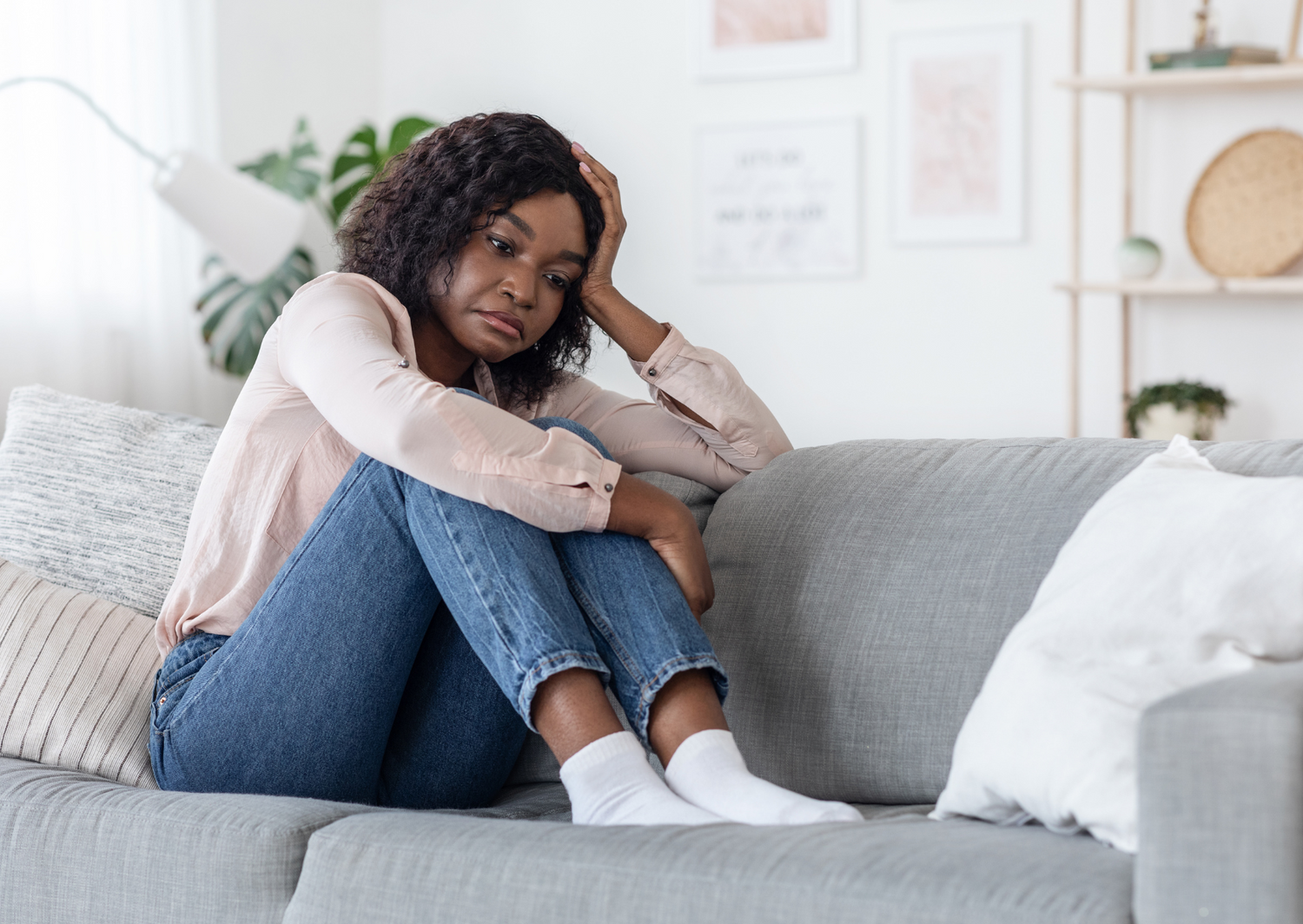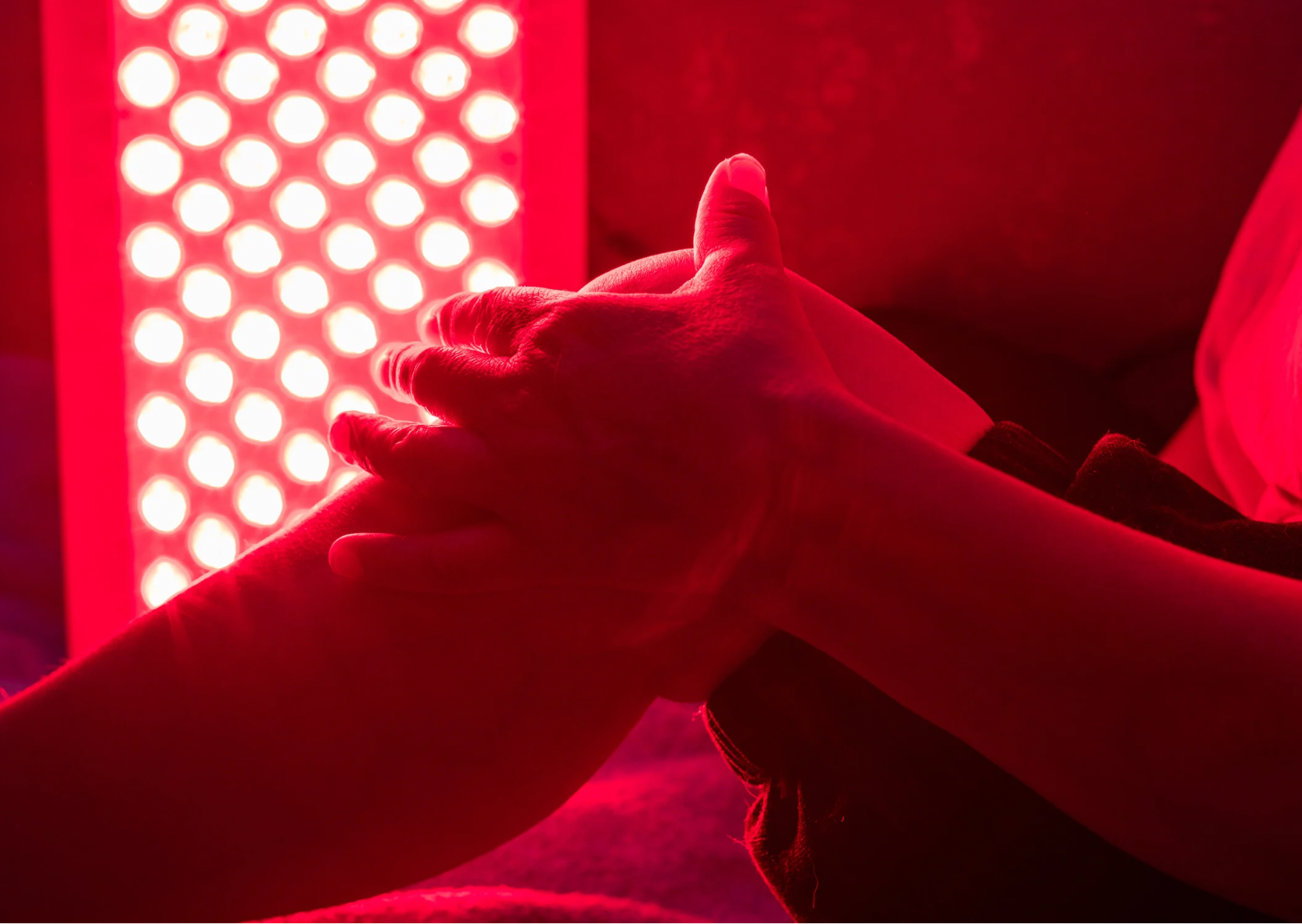Shorter days, less sunshine - we can already feel our mood and energy taking a nosedive.
Getting enough sunlight during the winter is a struggle in many parts of the world, especially when our jobs drive us indoors, working until the sun goes down. If this wasn’t throwing off our circadian rhythms enough, we’re then exposing ourselves to light devices such as phones, TVs, and computers, after sunset.
One study on >85,000 people demonstrated that this exposure to light at night (including light from devices, TVs, fluorescent lamps etc.) can increase the risk of developing anxiety and depression by 20% [1]. Furthermore, lack of exposure to natural light in the workplace has been associated with higher stress (cortisol) levels and lower levels of melatonin, relating to poor quality of sleep and depressive symptoms [2].
About 5% of adults in the US face a more intense version of the "winter blues," commonly referred to as Seasonal Affective Disorder (SAD) [44]. This condition is recognized as a form of depression that typically sneaks in during the fall and winter months. It is common for the affected population to experience mood changes and a distressing interference with daily function for about 40% of the year.
We don’t know exactly what causes SAD, but the prevailing hypothesis suggests that insufficient light worsens the brain's chemical imbalance due to shorter daylight and reduced sunlight.
This seasonal shift can mess with our body clock (aka circadian rhythm) and those feel-good chemicals like serotonin (happy hormone) and melatonin (sleep hormone), leading to symptoms such as low mood, fatigue, poor sleep, and increased irritability.
Common Treatments
Serotonin is a powerful chemical messenger in our brain that most people know as the ‘happy hormone’. Some antidepressants (most commonly SSRIs) could help increase the level of serotonin in the brain so doctors sometimes prescribe these to help lift mood.
While SAD can be treated with medications, and we always suggest you take advice from your healthcare practitioner, there may be some lifestyle measures to ease its severity that you can consider with your doctor.
There is light at the end of the tunnel…
The most common approach for managing SAD is light therapy using full spectrum light, which consists of exposure to bright white lights that your brain thinks is sunlight. According to the American Psychiatric Association, the trick is to use a SAD lamp as soon as you wake up for 20-30 minutes [28]. Studies have shown that light therapy has a direct relationship with serotonin [3] in multiple parts of the brain [4]. In fact, a study [5] found that light therapy can be as effective as some antidepressant medications in treating SAD.
Interestingly, a study on 10 patients found that light exposure through the eyes was more beneficial for mood than exposure through skin [26]. We are not recommending that you look at the light directly - it depends on the device and your health status, so please check with your doctor to make sure the device you are using is safe for your eyes.
But How About Red Light as Opposed to Full Spectrum Light?
Red light is just one range of wavelengths that make up the full spectrum, white light. Inadequate light exposure also means we’re deprived of red light wavelengths, which are crucial for our body to function optimally.

Red light therapy (RLT) is a non-invasive, natural treatment that uses low-level red or near-infrared light (NIR) to improve overall well-being by supporting cellular function.
Research has shown that specific wavelengths of red and near-infrared light can penetrate the skin and reach deeper tissues, improving mitochondrial production of adenosine triphosphate (ATP) [6], this is the currency of energy in our body, which ALL cells use to perform function (except red blood cells). For example, our brain cells use ATP to help us think clearly and remember things. When our cells have more ATP, they work better. As a result, we might experience a range of benefits.
So, let's dig in and uncover how red light might help us, and our loved ones, on those long winter days. ⬇️
Studies show RLT might just be the mood lifter we need.
RLT targets dozens of mechanisms at the molecular, cellular and tissue level.
Recent animal and clinical studies [7, 8, 9] have shown that specific wavelengths of light can be like a pick-me-up for our brain cells.
This “wavelength window” of biological stimulation is between 600 and 1150 nm, since below 600 nm renders absorption and scattering of light, while anything higher than 1150 nm is absorbed by water [10].
How does it work?
Researchers believe that nerve cell growth and nerve functionings have a major impact on depression [14]. A large amount of evidence also suggests depression is a multi-factorial process correlated with a reduction in metabolic activity in the brain [15], abnormal blood flow [16], oxidative stress [17], neuroinflammation [18], and neurotransmitter deficiency [19].
It is hypothesized that NIR light may accelerate the repair of such cells by increasing mitochondrial activity, boosting cerebral metabolism, promoting neuroplasticity, and modulating hormones that regulate mood, stress, and pain, while decreasing inflammation and oxidative stress [22] - more research is needed for definitive conclusions.
Although the benefits of red light mostly apply to the irradiated area, red and NIR may also have systemic effects [10]. What this means is red light therapy may provide cognitive or mood benefits even when the head is shielded from light [13].
What Does the Science Say?
Several studies have demonstrated positive effects for mental well-being with the use of red light and near-infrared light therapy [21, 24, 7].
Emotional regulation:
In a 21-person double-blind randomized control trial, patients were given NIR treatments directed at their head twice a week for 8 weeks. NIR was delivered using LED light at 823nm and irradiance of 33.2mW/cm2 to the front and sides of the head head [20].
Patients were assessed using the Hamilton Depression Rating Scale (HAM-D17), the most widely used assessment scale in antidepressant clinical trials, and a self reported Quick Inventory of Depressive Symptomatology (QIDS). The study findings revealed a statistically significant decrease in HAM-D17 scores among test subjects compared to those receiving the placebo. QIDS self reports also showed significance for the antidepressant effects of NIR in all study completers, suggesting that light therapy has benefits for emotional regulation.
Easing the symptoms of depression:
A 2018 case study concluded that when patients with lower back pain were treated with RLT, they not only experienced pain relief, but depressive symptoms also eased [22]. In this study a total of three 6-minute treatments were carried out over 2 weeks. Light was delivered to the thighs and the lower back at roughly 75% NIR (850 nm) and 25% red light (660 nm) with an average irradiance of 100mW/cm2. (For context, LUMEBOX delivers LED red light at 660 nm and NIR at 850nm, irradiance 125 mW/cm2 and 140 mW/cm2 respectively). OMSQ depression scores significantly decreased in the group receiving RLT.
This study also provides evidence that RLT may not have to be directly applied to the head or brain to see benefits.
Another study found that in rats, near-infrared low light therapy was equally as effective as Citalopram, an antidepressant [9], but more research on human groups is needed to reaffirm this.
Increase happiness:
There is also growing research revealing how NIR light may increase our happy hormone serotonin. Serotonin is a neurotransmitter associated with mood regulation, and low levels are often found in those suffering with low mood. Another study applying NIR laser to the top of the head found that “NIR had an anti-anxiety and anti-depressive effect in chronic restraint stress mice, which is probably linked to increasing serotonin” [23].
Low mood is not the only symptom of SAD.
Reduced energy, stress, and poor sleep can also play a part. Red light is great for supporting healthy hormones such as cortisol (stress), serotonin (“feel-good” factor), nitric oxide (improves blood flow), and melatonin (sleep hormone). Here are some interesting studies that demonstrate the role of RLT in easing these symptoms:
Energy:
Mitochondrial dysfunction [25] and inflammation are the core of chronic fatigue [29]. In Joseph Tafur’s research [30], he hypothesizes that “the mitochondrial electron transport chain has been shown to be sensitive to red and near-infrared (NIR) light. Although the underlying mechanisms have not yet been clearly elucidated, mitochondrial photostimulation has been shown to increase ATP production”, suggesting that red light amplifies energy synthesis in our cells.
Stress:
Trials on mice have shown that light therapy treatments using 810 nm laser (this is light in the near infrared range) decrease cortisol levels by mediating oxidative stress, reducing inflammation, and improving brain function [23, 24].
Sleep hormonal balance:
Research conducted by the China Institute of Sport Science found that “red light may positively affect sleep quality and endurance performance.” In their small study of 20 female athletes, participants lay on a whole-body red-light treatment machine (average wavelength 658 nm) for 30 minutes before bed for 2 weeks. Participants were assessed using the Pittsburgh Sleep Quality Index (PSQI) questionnaire. The group receiving red-light treatment showed correlation between improved sleep (demonstrated by greater improvement in global PSQI scores) and measured melatonin levels, as well as a 13% increase in athletic performance [27].
Good sleep equals a better mood!
Conclusion
With ongoing research and advancements in photobiomodulation technology, red light therapy may become an increasingly valuable tool as an adjunct to other modalities to temporarily relieve low mood or energy in the winter.
Moreover, specific parameters in red light therapy, notably the NIR 800-830 nm range, have been shown to be most effective, particularly when using lasers [11].
These studies most commonly apply NIR transcranially (via light probes on the skull/forehead) or intranasal (targeting the pituitary gland through the eye sockets or nasal cavity).
Note: Patients are often directed to wear goggles during the process if light is applied to the forehead.
For tissue penetration, NIR (near infrared) is superior to red light. Since the skull is thick, NIR’s lower frequency wavelengths are more likely to reach the brain and brain cells directly, “correlating with increased blood flow and circulation to the brain, improved energy, brain repair, decreased inflammation and optimized neuroprotection”, writes Dr. Hamblin [6].
In order to penetrate the human skull, irradiance of light therapy is usually increased. The most effective NIR irradiance for penetrating the skull to reach the brain tissue is still unknown, but according to Henderson et al., a very high wattage is needed [12].
If you or your loved ones are experiencing SAD, of course, there are many other tools to help well-being such as exercise, eating a healthier diet, and spending time in outdoor light. Red light therapy could be one approach you consider to a more vibrant and balanced you, but make sure you use a unit that delivers enough irradiance and always be guided by your own doctor!
New to red light therapy? Download our free eBook to help you choose the best device.
Already have a LUMEBOX? Download our 6 time-saving tricks guide!
Medical Disclaimer: The information contained in this blog post is intended for educational purposes only and should not be used as medical advice. Everyone responds to light differently. Testimonials are not a guarantee of the results you or anyone who uses LUMEBOX will get because your success depends entirely on your circumstances, and the studies on red light therapy shared were not specifically performed using LUMEBOX. Please check with your doctor before using red light therapy and do not change your medical treatments or lifestyle without consulting your physician first.
References:
[1] Burns, A.C., Windred, D.P., Rutter, M.K. et al. Day and night light exposure are associated with psychiatric disorders: an objective light study in >85,000 people. Nat. Mental Health 1, 853–862 (2023). https://doi.org/10.1038/s44220-023-00135-8
[2] Harb F, Hidalgo MP, et al. Lack of exposure to natural light in the workspace is associated with physiological, sleep and depressive symptoms.Chronobiology International. 2015 April.
[3] Harrison, S. J., Tyrer, A. E., Levitan, R. D., Xu, X., Houle, S., Wilson, A. A., Nobrega, J. N., Rusjan, P. M., & Meyer, J. H. (2015). Light therapy and serotonin transporter binding in the anterior cingulate and prefrontal cortex. Acta psychiatrica Scandinavica, 132(5), 379–388. https://doi.org/10.1111/acps.12424
[4] Tyrer, A. E., Levitan, R. D., Houle, S., Wilson, A. A., Nobrega, J. N., Rusjan, P. M., & Meyer, J. H. (2016). Serotonin transporter binding is reduced in seasonal affective disorder following light therapy. Acta Psychiatrica Scandinavica, 134(5), 410-419.
[5] Lam, R. W., Levitt, A. J., Levitan, R. D., Enns, M. W., Morehouse, R., Michalak, E. E., & Tam, E. M. (2006). The Can-SAD Study: A Randomized Controlled Trial of the Effectiveness of Light Therapy and Fluoxetine in Patients With Winter Seasonal Affective Disorder. American Journal of Psychiatry, 163(5), 805-812. DOI Link
[6] Hamblin M. R. (2016). Shining light on the head: Photobiomodulation for brain disorders. BBA clinical, 6, 113–124. https://doi.org/10.1016/j.bbacli.2016.09.002
[7] Salehpour, F. and Rasta, S.H. (2016). Transcranial low-level light therapy in psychological disorders-a review. Lasers Surg. Med. 48, 455–455.
[8] Schiffer F., Johnston A.L., Ravichandran C., Polcari A., Teicher M.H., Webb R.H., Hamblin M.R. Psychological benefits 2 and 4 weeks after a single treatment with near infrared light to the forehead: a pilot study of 10 patients with major depression and anxiety. Behav. Brain Funct. 2009;5:46.
[9] Salehpour F, Rasta SH, et al. Therapeutic effects of 10-HzPulsed wave lasers in rat depression model: A comparison between near-infrared and red wavelengths. Lasers in Surgery and Medicine. 2016 September.
[10] Michael R. Hamblin and Tatiana N Demidova "Mechanisms of low level light therapy", Proc. SPIE 6140, Mechanisms for Low-Light Therapy, 614001 (10 February 2006); https://doi.org/10.1117/12.646294
[11] Montazeri, K., Farhadi, M., Fekrazad, R. et al. Photobiomodulation therapy in mood disorders: a systematic review. Lasers Med Sci 37, 3343–3351 (2022). https://doi.org/10.1007/s10103-022-03641-w
[12] Henderson, T. A., & Morries, L. D. (2015). Near-infrared photonic energy penetration: can infrared phototherapy effectively reach the human brain?. Neuropsychiatric disease and treatment, 11, 2191–2208. https://doi.org/10.2147/NDT.S78182
[13] Johnstone D.M., Mitrofanis J., Stone J. Targeting the body to protect the brain: inducing neuroprotection with remotely-applied near infrared light. Neural Regen. Res. 2015;10:349–351
[14] Duman, R. S. (2009). Neuronal damage and protection in the pathophysiology and treatment of psychiatric illness: stress and depression. Dialogues in Clinical Neuroscience, 11(3), 239–255. https://doi.org/10.31887/DCNS.2009.11.3/rsduman
[15] Iosifescu, D.V., Bolo, N.R., Nierenberg, A.A., Jensen, J.E., Fava, M., and Renshaw, P.F. (2008). Brain bioenergetics and response to triiodothyronine augmentation in major depressive disorder. Biol. Psychiatry 63, 1127–1134.10.1016/j.biopsych.2007.11.020
[16] Videbech, P. (2000). PET measurements of brain glucose metabolism and blood flow in major depressive disorder: a critical review. Acta Psychiatr. Scand. 101, 11–20.10.1034/j.1600-0447.2000.101001011.x
[17] Gawryluk, J.W., Wang, J.-F., Andreazza, A.C., Shao, L., and Young, L.T. (2011). Decreased levels of glutathione, the major brain antioxidant, in post-mortem prefrontal cortex from patients with psychiatric disorders. Int. J. Neuropsychopharmacol. 14, 123–130.
[18] Zunszain, P.A., Hepgul, N., and Pariante, C.M. (2012). Inflammation and depression. Behavioral Neurobiology of Depression and Its Treatment. (Berlin Heidelberg: Springer), pp. 135–151.10.1007/7854_2012_211
[19] Hamon, M. and Blier, P. (2013). Monoamine neurocircuitry in depression and strategies for new treatments. Prog. Neuropsychopharmacol. Biol. Psychiatry 45, 54–63.10.1016/j.pnpbp.2013.04.009
[20] Cassano P, Petrie SR, et al. Transcranial Photobiomodulation for the Treatment of Major Depressive Disorder. The ELATED-2 Pilot Trial. Photomedicine and Laser Surgery. 2018 October.
[21] Henderson TA, Morries LD. Multi-Watt Near-Infrared Phototherapy for the Treatment of Comorbid Depression: An Open-Label Single-Arm Study. Frontiers in Psychology. 2017 September.
[22] Gabel C, Petrie S, et al. A case control series for the effect of photobiomodulation in patients with low back pain and concurrent depression. Laser Therapy. 2018.
[23] Eshaghi E, Sadigh-Eteghad S, et al. Transcranial photobiomodulation prevents anxiety and depression via changing serotonin and nitric oxide levels in brain of depression model mice: A study of three different doses of 810 nm laser. Lasers in Surgery and Medicine. 2019 September.
[24] Salehpour F, Farajdokht F, et al. Near-infrared photobiomodulation combined with coenzyme Q10 for depression in a mouse model of restraint stress: reduction in oxidative stress, neuroinflammation, and apoptosis. Brain Research Bulletin. 2019 January.
[25] Pagano, G., Talamanca, A. A., Castello, G., Cordero, M. D., d'Ischia, M., Gadaleta, M. N., Pallardó, F. V., Petrović, S., Tiano, L., & Zatterale, A. (2014). Oxidative stress and mitochondrial dysfunction across broad-ranging pathologies: toward mitochondria-targeted clinical strategies. Oxidative medicine and cellular longevity, 2014, 541230. https://doi.org/10.1155/2014/541230
[26] Wehr, T. A., Skwerer, R. G., Jacobsen, F. M., Sack, D. A., & Rosenthal, N. E. (1987). Eye versus skin phototherapy of seasonal affective disorder. The American journal of psychiatry, 144(6), 753–757. https://doi.org/10.1176/ajp.144.6.753
[27] Zhao, J., Tian, Y., Nie, J., Xu, J., & Liu, D. (2012). Red light and the sleep quality and endurance performance of Chinese female basketball players. Journal of athletic training, 47(6), 673–678. https://doi.org/10.4085/1062-6050-47.6.08
[28] Seasonal Affective Disorder, American Psychatric Association https://www.psychiatry.org/patients-families/seasonal-affective-disorder
[29] Montoya, J. G., Holmes, T. H., Anderson, J. N., Maecker, H. T., Rosenberg-Hasson, Y., Valencia, I. J., Chu, L., Younger, J. W., Tato, C. M., & Davis, M. M. (2017). Cytokine signature associated with disease severity in chronic fatigue syndrome patients. Proceedings of the National Academy of Sciences of the United States of America, 114(34), E7150–E7158. https://doi.org/10.1073/pnas.1710519114
[30] Tafur, J., & Mills, P. J. (2008). Low-intensity light therapy: exploring the role of redox mechanisms. Photomedicine and laser surgery, 26(4), 323–328. https://doi.org/10.1089/pho.2007.2184




